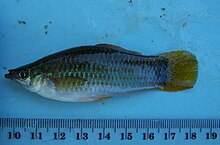Poecilia gillii
| Gill's molly | |
|---|---|

| |
| A male | |

| |
| A female | |
| Scientific classification | |
| Domain: | Eukaryota |
| Kingdom: | Animalia |
| Phylum: | Chordata |
| Class: | Actinopterygii |
| Order: | Cyprinodontiformes |
| Family: | Poeciliidae |
| Genus: | Poecilia |
| Species: | P. gillii
|
| Binomial name | |
| Poecilia gillii Kner, 1863
| |
Poecilia gillii, Gill's molly, is a
brackish
habitats. Populations of this species differ in color, size, and morphology.
Description
Poecilia gillii is primarily greyish with blue highlights and rows of yellow spots on the sides. Females from some
caudal fin, usually has spots or black blotches close to the fish's body. The caudal fin of the males from some tideland populations is edged orange. Some other populations contain males with the dorsal and caudal fins colored red.[2]
The dorsal fin of P. gillii males is among the largest of the non-courting males in the Poecilia sphenops (shortfin molly) species complex.[3] The species is most similar to P. mexicana.[2]
-
A red fin form male
-
A yellow fin form male
-
A female
Distribution and habitat
Poecilia gillii is widespread in Central America, occurring from Guatemala to Colombia on its
Pacific slope. In Costa Rica, it is the most common freshwater fish species.[3][2] The molly's range continues in Panama from the Grande River to the Bayano River.[2]
The species is found in greatest numbers in
brackish water tend to be larger than those observed in brooks, reaching up to 105 mm. The temperatures of these habitats range from 19 to 37 °C.[2]
In the
Tomocichla sieboldii.[3]
Diet
Poecilia gillii is a
filamentous algae.[2]
Reproduction
Poecilia gillii is a
livebearer, meaning that females give birth to live fry.[3] It reproduces continuously year-round, with most juveniles appearing in August.[2]
In some
gonopodium, is longer in the small males in order to facilitate the sneaking up and chasing type of copulation.[3]
References
- . Retrieved 23 August 2023.
- ^ ISBN 9977674892.
- ^ .


